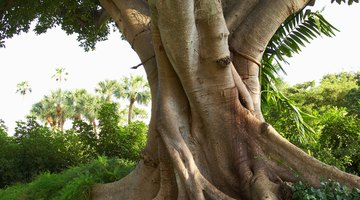Trees With Roots That Will Infiltrate Your Septic Tank
Waste water leaves a home via a "lateral" line -- a pipe that connect drains to the public sewer main, septic tank or cesspool. Over time, shifting soil or earthquake damage can separate or crack a lateral line. Roots from nearby trees infiltrate the pipe, creating blockage and clogged drains. The lateral line must then be cleaned with a drain auger. The best way to avoid the problem is to not plant trees with aggressive root systems near septic tanks, drain fields or plumbing pipes.
Tree Root Growth

Different species of trees have different types of root systems. Some are fine and compact. However, the majority of trees present root systems that extend outward and down in balance with the top growth pattern of the tree. Visualize the roots as wide as the canopy of the tree and as deep as the height of the tree. When establishing a new septic system, always keep trees a minimum of 100 feet away from the drain field. Trees with aggressive roots should be planted much farther away from the field.
Populus
Aspens, poplars and cottonwoods present wide-spreading, enormous root systems that spread, seeking moisture. These trees are some of the worst trees to plant near septic tanks, drain fields, home foundations, sidewalks or driveways. Their aggressive root systems help the tree survive in its native environment, but they quickly become a problem in urban landscape designs.
Ulmus
Elms are deciduous and semi-deciduous trees in the plant family Ulmaceae. American Elm (Ulmus Americana) is a popular and widely planted landscape tree found in parks, along city streets and in home landscapes. Stately and elegant, elms provide welcome shade and visual interest but should not be planted near septic tanks, pipes or water features. Elms develop deep and widespread roots that exert extreme pressure, breaking pipes and invading sewage systems.
Salix
Willows have aggressive, widespread root systems that tenaciously seek water. Providing a graceful accent when planted along stream banks or ponds, willows are attractive landscape elements. Planted near a septic tank, willows will create a root problem. All species of willows should be avoided near septic tanks, foundations or water mains.
More Trees to Avoid
Avoid planting bamboo, beech, banyan, fig, cypress, walnut, silver and red maple trees near the septic tank and drain field. All have deep and aggressive root systems that will infiltrate and damage your pipes and septic tank system over time. Fruit-bearing trees should also be avoided near the septic tank system. The fruit may be contaminated by leaking sewage and is unsafe for human consumption.
References
Writer Bio
A passionate writer for more than 30 years, Marlene Affeld writes of her love of all things natural. Affeld's passion for the environment inspires her to write informative articles to assist others in living a green lifestyle. She writes for a prominent website as a nature travel writer and contributes articles to other online outlets covering wildlife, travel destinations and the beauty of nature.
Photo Credits
- Jupiterimages/Photos.com/Getty Images
More Articles



